Walsingham
|
England's Nazareth has been a place of pilgrimage since Saxon times and is famous for its Shrine of Our Lady and its ruined priory. |
|
An Introduction to Walsingham
|

In medieval times, Walsingham was one of the most important pilgrimage sites in the world and a rival to even Rome! That changed after the reformation, but a revival during the 19th century has put Walsingham back on the pilgrimage map and thousands now visit here each year, especially at Easter time. Walsingham is actually 2 villages about a mile apart - Little Walsingham is where the main attractions are located, with Great Walsingham located about a mile away and is much smaller, but still worth a visit. In the year 1061, Lady Richeldis, owner of Walsingham manor, had a vision in which she was taken by Mary and shown the house in Nazareth where Gabriel had announced the news of the birth of Jesus. Mary asked her to build a replica of the house in Walsingham. It was a simple wooden structure and some years later, a priory was built around the house. This became a place of pilgrimage - England's Nazareth - even drawing Kings, unfortunately including Henry VIII, who brought about its destruction in 1538. The priory was wrecked and the Walsingham Madonna was taken to London and burned. Walsingham remained in ruins for almost
300 years, but the 19th century saw the restoration of Walsingham and in 1897, there was a Roman Catholic pilgrimage to the restored 14th century Slipper Chapel, now at the centre of the Roman Catholic National Shrine. A replica of Lady Richeldis's shrine was built in 1931 and daily mass is now held to the many visitors that flock here. The village itself has some lovely old medieval streets containing interesting shops. There is also a museum containing a courthouse from the times of George III. The main attractions however are the religious sites and the remains the priory. A steam railway brings visitors to Little Walsingham from Wells next the Sea on the Wells & Walsingham light railway. |
|
|
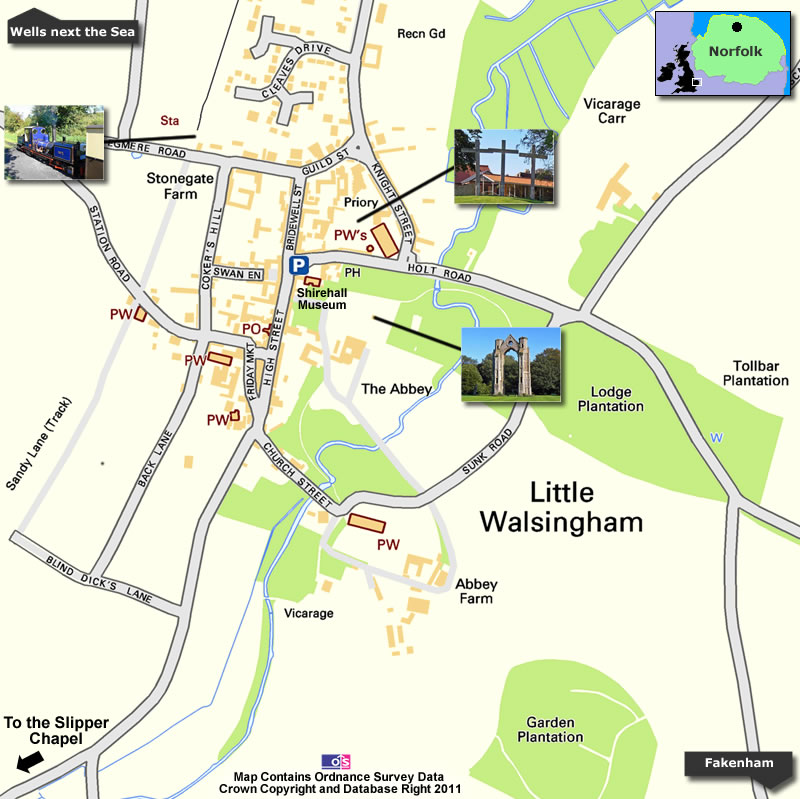
|
|
| |
|
Walsingham Guided Picture Tour
|
We start our tour in the centre of Little Walsingham. From here you can wander the historic streets of the village. The main street, for example, has many timber framed buildings and you will see various architecture from the 15th to 18th centuries. You will also find some interesting shops to explore, many related to Walsingham's religious theme. |
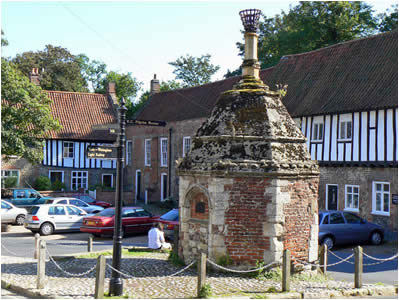
The centre of Little Walsingham, with a small car-park |
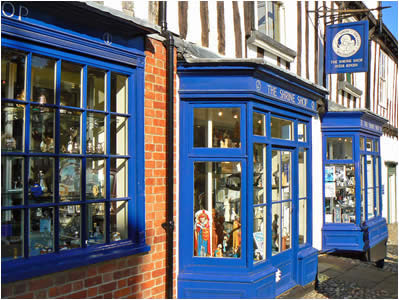
The Shrine Shop in Walsingham |
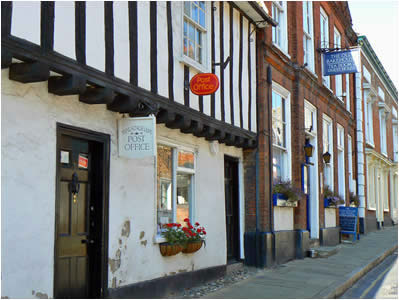
Little Walsingham High Street and Post Office |
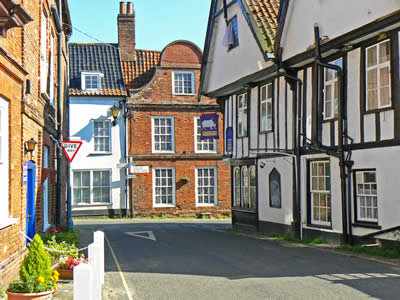
Medieval streets and alleys in Walsingham |
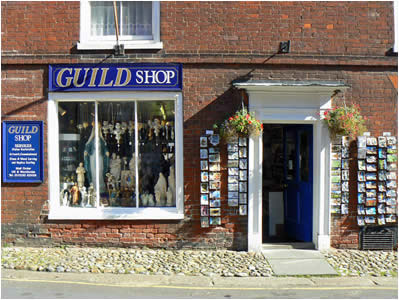
Guild Shop Little Walsingham |
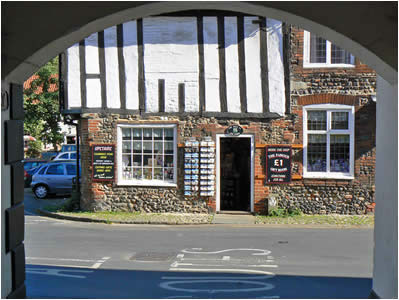
Old Buildings in Little Walsingham |
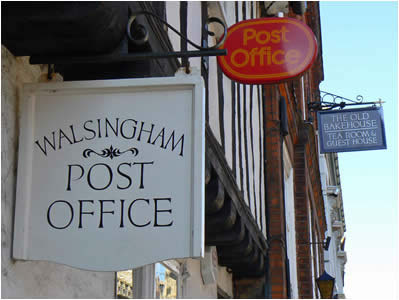
Shop signs in the main street |
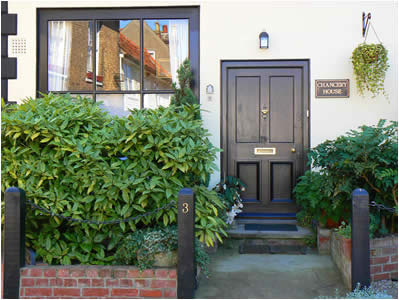
Walsingham Cottage Door |
Midway along the main street is the 13th century gateway leading to the remains of the Priory. The entrance to the priory is now through the Shirehall Museum (see below). |
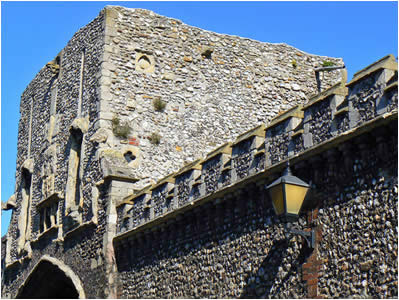
Priory Gateway Little Walsingham |
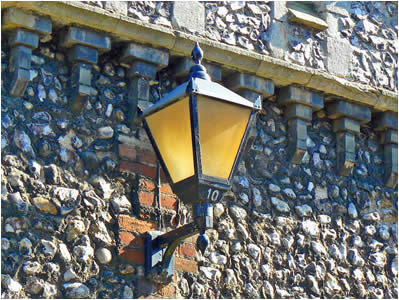
Street light on the Priory Gateway |
The village has a number of places to stop for a refreshment, including the 15th century Black Lion Hotel and the Swallows Tea Room. |
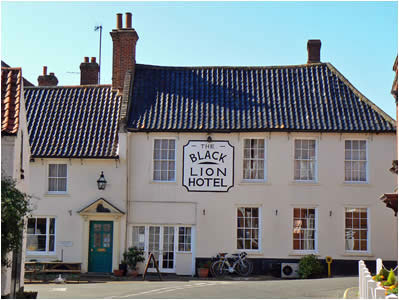
The Black Lion Hotel Little Walsingham |
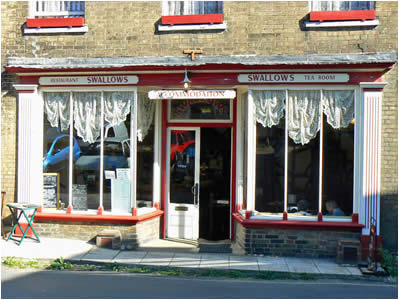
Swallows Tearoom Little Walsingham |
Below the centre of the village, is the entrance to the Shrine of our Lady. The Shrine Church is the highlight of the site and is situated in beautiful grounds. The Shrine Church, built in the 20th century, is where the Holy House is located - a replica of the home in Nazareth of Joseph, Mary and Jesus (the Holy Family).
You can also find an image of Our Lady of Walsingham, carved in 1922 and copied from the seal of the medieval Priory which was suppressed in 1538. |
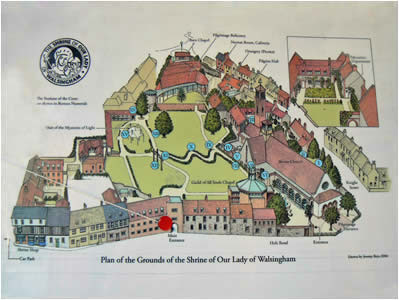
Plan of the Shrine of Our Lady of Walsingham |
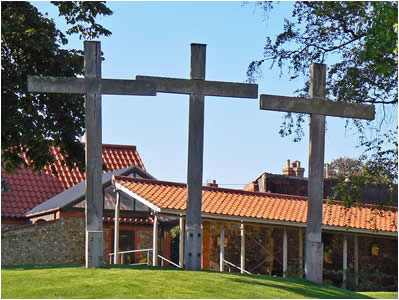
The grounds of the Shrine of our Lady in Walsingham |
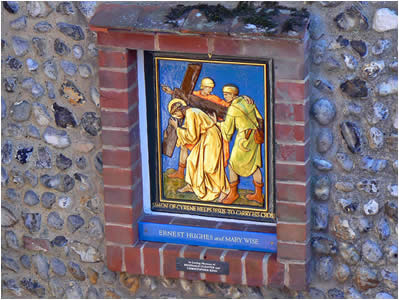
Jesus carrying the cross at the Shrine of our Lady |
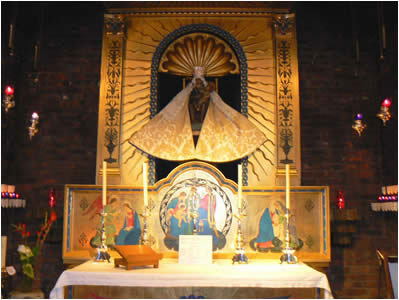
Grand Annunciation Altar and carving of Our Lady |
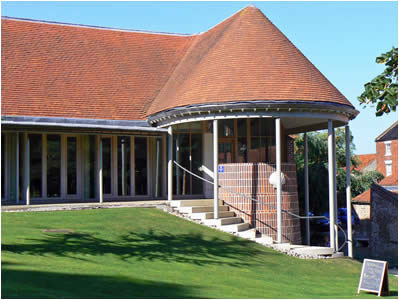
The newly built pilgrimage refectory |
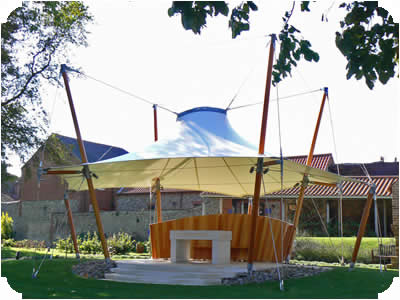
Altar of the Mysteries of Light |
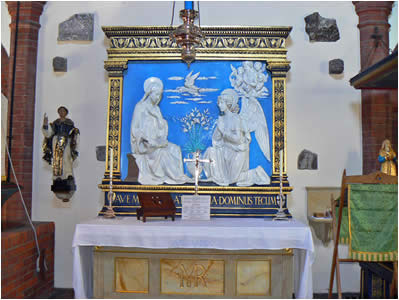
An altar in the Shrine of our Lady |
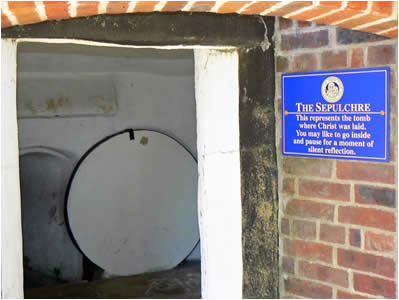
The Sepulchre, the tomb where Christ was laid |
In the centre of Little Walsingham is the Shirehall Museum.
Walsingham Shirehall was built in the early 16th century and was used as a hostel for important visitors to the Priory. It was converted into the Shirehall for a court of quarter sessions, which were held there until 1861, with petty sessions continuing until 1971.
The courtroom has survived since it was last used and is now part of the museum, which includes a comprehensive display on Walsingham as a place of pilgrimage, as well as local artifacts and photographs. |
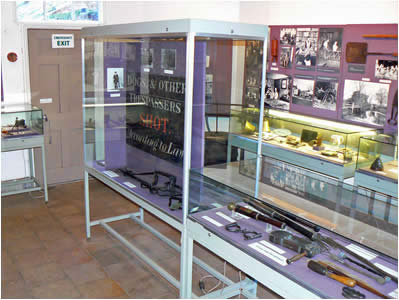
The Shirehall Museum Little Walsingham |
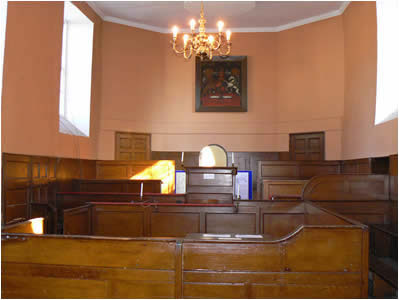
Courthouse at Walsingham Shirehall |
Through the Shirehall Museum is the entrance to the Priory Gardens.
Nothing remains of the original shrine, and very little has survived of the medieval priory. However, dominating the site, is the impressive, twin turreted 13th century arch, that would have housed the great east window of the priory church. There is a section of vaulted undercroft to the monks dormitory remaining, as well as the end of the south wall of the dining room.
The priory grounds are beautifully maintained, and in Spring the woodland setting is bursting with flowers, including bluebells, daffodils and brilliant white snowdrops. Walking along the footpath beside the River Stiffkey, a narrow stone bridge can be found and this was built as an access road for pack horses. In the garden area, you will also find two healing wells where the sick were brought in medieval times. |
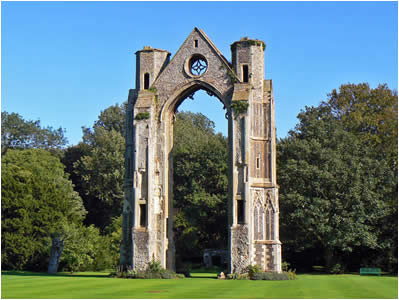
Priory Great Arch and East Window |
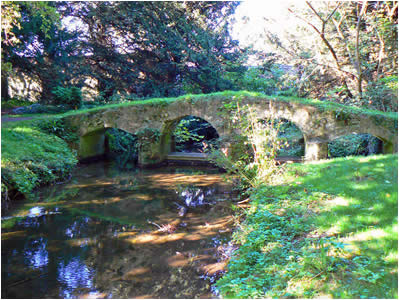
Pack Horse Bridge over the River Stiffkey |
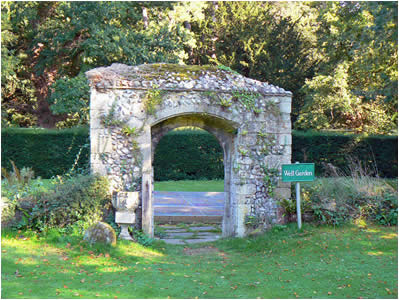
The Well Garden, healing the sick |
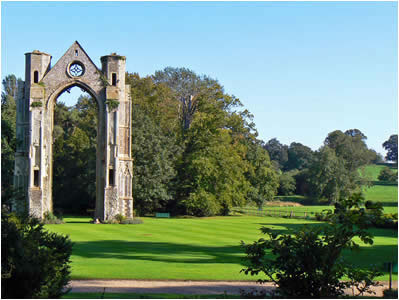
Priory Gardens Little Walsingham |
The Wells & Walsingham Light Railway takes visitors on a 4 mile journey from Wells to Walsingham. The railway was one man's passionate dream, hard work and sheer determination - Lt. Cmdr. Roy Francis. In 1979 he started to construct the WWLR on the 4 miles of old Great Eastern track bed from Wells to Walsingham. Work was completed in 1982 and on 6th April services began on schedule making it the longest 10¼" narrow gauge steam railway in the world. In 1987 a new unique 2-6-0 + 0-6-2 Garratt locomotive "Norfolk Hero" came into service and has a seating capacity of 76. |
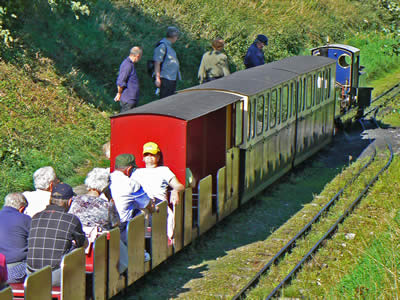
Train on the Wells Walsingham Light Railway |
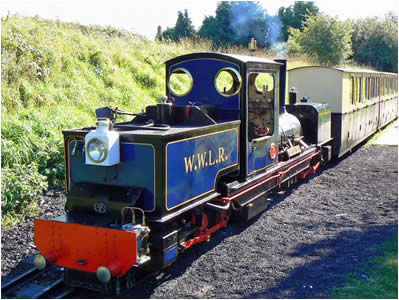
Narrow gauge steam train on the WWLR |
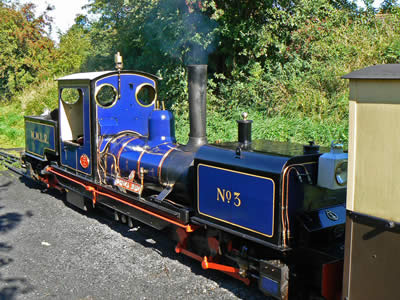
Norfolk Hero at Walsingham Station |

Norfolk Hero Steam Train |
A short distance south of Little Walsingham is the Roman Catholic Shrine, known as the Slipper Chapel.
It has been a place of pilgrimage for Catholics since medieval times,
when travel to Rome was virtually impossible. The original
Shrine, founded in 1061,
was destroyed at the Reformation.
Many years passed until the Slipper Chapel,
a 14th century wayside pilgrim chapel, was restored and in 1934, the English Bishops named the Slipper Chapel the Roman Catholic National Shrine of Our Lady.
Thousands of people visit the Shrine each year, some come out of a spiritual need for the atmosphere of peace that seems to emanate from the Chapel, whilst others merely stumble across it, nestled away in this secluded Norfolk valley. |
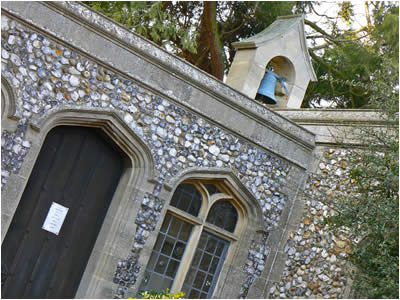
The Slipper Chapel |
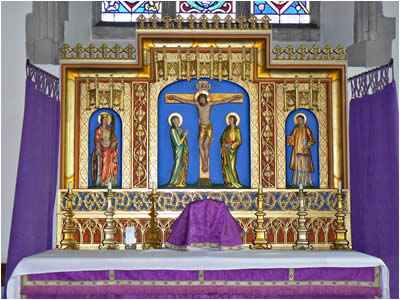
Slipper Chapel Altar |
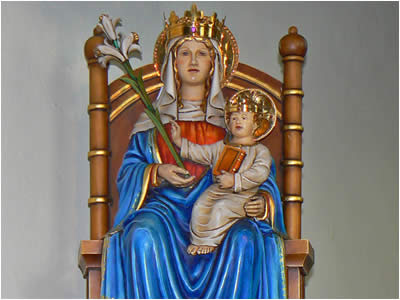
Figure of Our Lady |
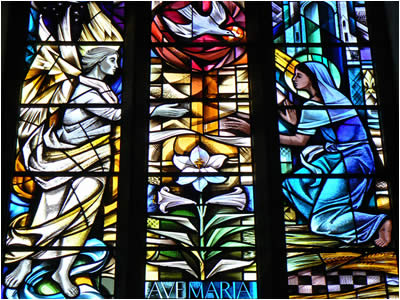
Stained Glass in the Slipper Chapel |
Walsingham Summary of What to SEE and DO
|
 Ride into Walsingham on the steam railway |
 Wander the old streets and browse the shops |
 Visit the pilgrimage Shrine of our Lady |
 Attend mass at one of the churches |
 Explore the Shirehall Museum and courtroom |
 Walk in the gardens of the priory |
 Take a refreshment in the tea rooms or pub |
 Visit the Slipper Chapel on the village outskirts |
|
|
Our Verdict
|
You do not need to be religious to appreciate Walsingham; the importance of this pilgrimage village becomes obvious as you wander the pretty streets. Make sure you do not miss the Roman Catholic Slipper Chapel on the way out of Walsingham, it is well worth a visit. |
|
|
TOUR INDEX |
|
|
|
|
|
|
|
|
|
NEARBY PICTURE TOURS |
|
|
|
|
|
|
|
|
|
|
|
TOURIST ATTRACTIONS |
 |
|
MORE OF OUR WEBSITES |
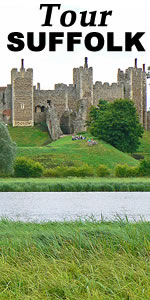 |
 |
 |
| |

|

